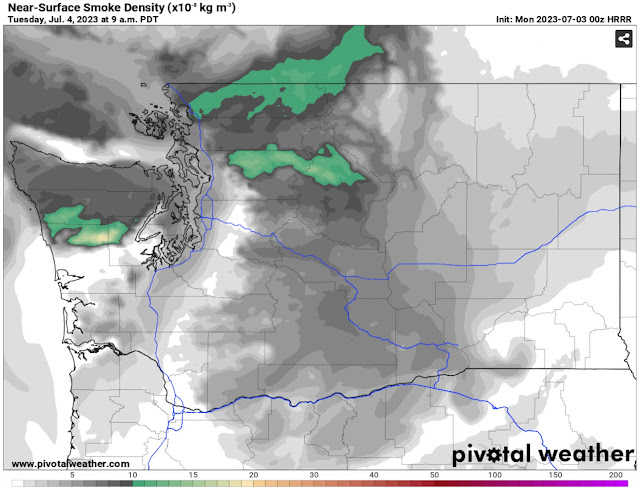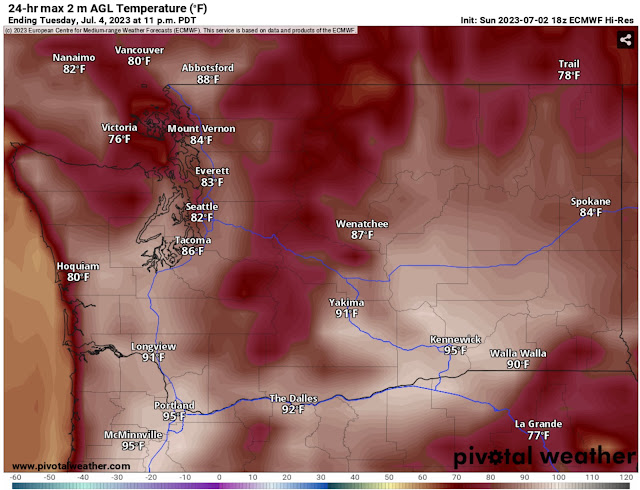FastCast—Monday, July 3 to Friday, July 7:
A hot, dry, and smoky Fourth of July is ahead across Washington state, with a heat wave, low relative humidity, and surface smoke from British Columbia wildfires will all impact the region for the Fourth and beyond. For the lowlands, expect smoke aloft to move in on Monday, with highs in the upper 70s to low 80s. Temperatures will increase on the Fourth, with highs increasing into the mid to upper 80s. Surface smoke from British Columbia will move south into Washington early on the Fourth, and air quality will likely degrade into the “moderate” or “unhealthy for sensitive groups” categories, even before widespread fireworks smoke. Around peak fireworks time, conditions will be clear (with smoke) and temperatures will likely be in the low to mid 70s with light northerly winds. On Wednesday, temperatures will peak, with highs in the upper 80s to low 90s across the lowlands. Conditions will remain hot on Thursday, in the mid to upper 80s. Some clouds will increase in the morning on Friday, and temperatures will decrease to the upper 70s to low 80s. Low temperatures will remain in the mid 50s to low 60s, not providing much relief at night. Additionally, relative humidity will be low (20-30%) on Monday and Tuesday (and likely beyond), and fire danger is higher than normal. Keep this in mind when handling fireworks. It’s too early to tell what will happen with smoke from Wednesday onward, so stay tuned.
—————————————————————
Continue reading the full blog below!
A hot, dry, and smoky Fourth of July is ahead for Washington state, with the potential for degraded air quality along with a heat wave. Let’s take a look at the forecast.
First, let’s take a look at the smoke forecast, starting with vertically integrated smoke (smoke aloft). All our smoke forecasts will be from the high-resolution HRRR smoke forecast. Below is the smoke forecast at 9 AM Monday.
By 9 AM Monday, smoke aloft from British Columbia will have moved into Washington, with noticeably hazy skies and a reddish tint to the sun.
Smoke aloft will continue on the Fourth (Tuesday), as seen in the forecast for 9 AM Tuesday.
Notice that smoke aloft is thicker on the Fourth across the entire state, especially in Eastern Washington.
Now for what will really be noticed…surface smoke. Just to be clear, we are not expecting the severe surface smoke that has been seen recently in New York City and Chicago. This will be much more minor, but still noticeable.
Below is the forecast for surface smoke at 9 AM Tuesday.
Light concentrations of surface smoke will cover most of the state by Tuesday morning, with heavier concentrations in the Cascades, Olympics, and in Whatcom & Skagit Counties.
Through the day, surface smoke will continue increasing across the state, as seen in the forecast for 3 PM Tuesday.
By Tuesday afternoon, as Fourth of July celebrations are ramping up, most of Western Washington will have noticeable surface smoke and degraded air quality. Surface smoke will also be noticeable in Eastern Washington, with degraded AQI expected. Expect air quality to degrade into the “moderate” to “unhealthy for sensitive groups” categories. Use the AQI forecast links on the right side of the blog to follow current measurements.
While smoke is present across the state, temperatures will be increasing as a short heat wave begins to impact the region, though smoke will likely keep temperatures below the values listed below.
Let’s take a look at the European model forecast for Monday, seen below.
On Monday, expect lowland highs in the mid 70s to low 80s, hottest south and east of Seattle. Areas from Tacoma southward will reach the low to mid 80s, the Willamette Valley will reach the upper 80s to low 90s, and the coast will reach the mid 60s to low 70s. In Eastern Washington, highs will reach the low 80s to mid 90s.
Temperatures will be even hotter on the Fourth, as seen in the European model forecast below.
Expect lowland highs in the mid to upper 80s, except in the upper 70s to low 80s near the water. From Tacoma south, highs will reach the mid 80s to low 90s, the Willamette Valley will reach the low to mid 90s, and the coast will reach the upper 60s on the beaches and low 80s inland. Eastern Washington will reach the mid 80s to mid 90s.
Wednesday will be the hottest day for areas west of the Cascades, as seen below in the European model forecast.
In the lowlands, expect highs in the mid 80s to low 90s. Highs will reach the low to mid 90s from Tacoma to Kelso, the upper 90s to low 100s in the Willamette Valley, and the upper 60s on the beaches/mid 70s inland. Eastern Washington will increase to the upper 80s to low 100s, hottest in the Columbia Basin.
In addition to the hot temperatures, nighttime lows will provide little relief from the heat. Below is the European model forecast for lows on the morning of the Fourth.
Expect Tuesday morning’s lows to only drop to the mid to upper 50s for the lowlands and Willamette Valley, the low to mid 50s on the coast, and the mid 50s to upper 60s in Eastern Washington.
Wednesday morning’s lows will be similar, as seen in the European model’s forecast below.
Wednesday morning’s lows will be even warmer, likely in the upper 50s to low 60s in the lowlands, in the low to mid 60s on the coast, and in the upper 50s to upper 60s for Eastern Washington and the Willamette Valley. Additionally, with light winds, lingering smoke from fireworks shows and private fireworks will likely linger, especially in urban areas, which will produce degraded air quality in addition to surface smoke from BC wildfires.
Finally, to add one more aspect to a hot & smoky holiday, it will also be quite dry. Below is the European model’s forecast for relative humidity at 5 PM on the Fourth.
This forecast shows relative humidity in the lowlands dropping to the 20-30% range (except on the coast, Whidbey Island, and the San Juans). Eastern Washington will be far drier, with relative humidity of 5-15%. With dry conditions, dry fuels (grasses, vegetation, etc.), and breezy northerly winds, the entire state is primed for fire starts, whether they are grass, brush, residential, or forest fires. This doesn’t even factor in the incredible fire risk posed by fireworks, so take extreme caution when burning or lighting off fireworks. It only takes one spark to start a devastating fire.











No comments:
Post a Comment